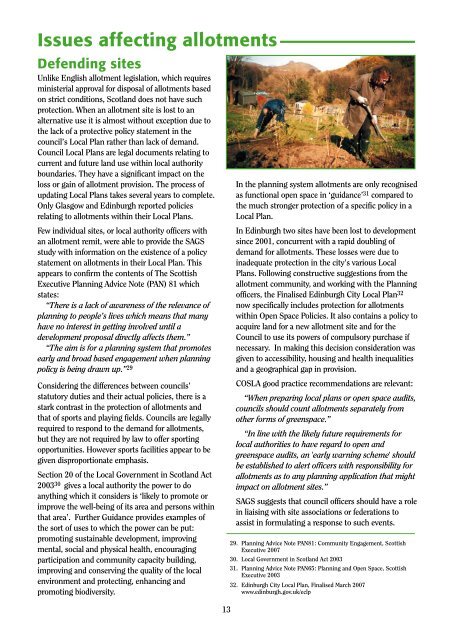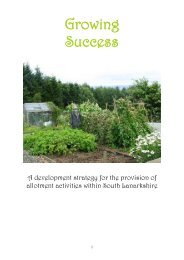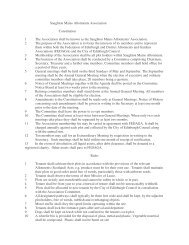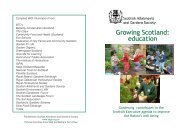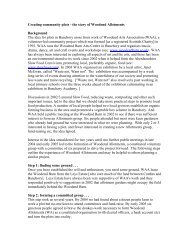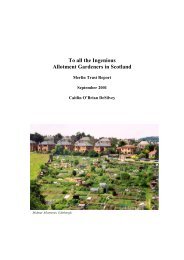Finding Scotland's Allotments. - Scottish Allotments and Gardens ...
Finding Scotland's Allotments. - Scottish Allotments and Gardens ...
Finding Scotland's Allotments. - Scottish Allotments and Gardens ...
You also want an ePaper? Increase the reach of your titles
YUMPU automatically turns print PDFs into web optimized ePapers that Google loves.
Issues affecting allotments<br />
Defending sites<br />
Unlike English allotment legislation, which requires<br />
ministerial approval for disposal of allotments based<br />
on strict conditions, Scotl<strong>and</strong> does not have such<br />
protection. When an allotment site is lost to an<br />
alternative use it is almost without exception due to<br />
the lack of a protective policy statement in the<br />
council’s Local Plan rather than lack of dem<strong>and</strong>.<br />
Council Local Plans are legal documents relating to<br />
current <strong>and</strong> future l<strong>and</strong> use within local authority<br />
boundaries. They have a significant impact on the<br />
loss or gain of allotment provision. The process of<br />
updating Local Plans takes several years to complete.<br />
Only Glasgow <strong>and</strong> Edinburgh reported policies<br />
relating to allotments within their Local Plans.<br />
Few individual sites, or local authority officers with<br />
an allotment remit, were able to provide the SAGS<br />
study with information on the existence of a policy<br />
statement on allotments in their Local Plan. This<br />
appears to confirm the contents of The <strong>Scottish</strong><br />
Executive Planning Advice Note (PAN) 81 which<br />
states:<br />
“There is a lack of awareness of the relevance of<br />
planning to people’s lives which means that many<br />
have no interest in getting involved until a<br />
development proposal directly affects them.”<br />
“The aim is for a planning system that promotes<br />
early <strong>and</strong> broad based engagement when planning<br />
policy is being drawn up.” 29<br />
Considering the differences between councils’<br />
statutory duties <strong>and</strong> their actual policies, there is a<br />
stark contrast in the protection of allotments <strong>and</strong><br />
that of sports <strong>and</strong> playing fields. Councils are legally<br />
required to respond to the dem<strong>and</strong> for allotments,<br />
but they are not required by law to offer sporting<br />
opportunities. However sports facilities appear to be<br />
given disproportionate emphasis.<br />
Section 20 of the Local Government in Scotl<strong>and</strong> Act<br />
2003 30 gives a local authority the power to do<br />
anything which it considers is ‘likely to promote or<br />
improve the well-being of its area <strong>and</strong> persons within<br />
that area’. Further Guidance provides examples of<br />
the sort of uses to which the power can be put:<br />
promoting sustainable development, improving<br />
mental, social <strong>and</strong> physical health, encouraging<br />
participation <strong>and</strong> community capacity building,<br />
improving <strong>and</strong> conserving the quality of the local<br />
environment <strong>and</strong> protecting, enhancing <strong>and</strong><br />
promoting biodiversity.<br />
29.<br />
30.<br />
31.<br />
32.<br />
In the planning system allotments are only recognised<br />
as functional open space in ‘guidance’ 31 compared to<br />
the much stronger protection of a specific policy in a<br />
Local Plan.<br />
In Edinburgh two sites have been lost to development<br />
since 2001, concurrent with a rapid doubling of<br />
dem<strong>and</strong> for allotments. These losses were due to<br />
inadequate protection in the city’s various Local<br />
Plans. Following constructive suggestions from the<br />
allotment community, <strong>and</strong> working with the Planning<br />
officers, the Finalised Edinburgh City Local Plan 32<br />
now specifically includes protection for allotments<br />
within Open Space Policies. It also contains a policy to<br />
acquire l<strong>and</strong> for a new allotment site <strong>and</strong> for the<br />
Council to use its powers of compulsory purchase if<br />
necessary. In making this decision consideration was<br />
given to accessibility, housing <strong>and</strong> health inequalities<br />
<strong>and</strong> a geographical gap in provision.<br />
COSLA good practice recommendations are relevant:<br />
“When preparing local plans or open space audits,<br />
councils should count allotments separately from<br />
other forms of greenspace.”<br />
“In line with the likely future requirements for<br />
local authorities to have regard to open <strong>and</strong><br />
greenspace audits, an 'early warning scheme' should<br />
be established to alert officers with responsibility for<br />
allotments as to any planning application that might<br />
impact on allotment sites.”<br />
SAGS suggests that council officers should have a role<br />
in liaising with site associations or federations to<br />
assist in formulating a response to such events.<br />
Planning Advice Note PAN81: Community Engagement, <strong>Scottish</strong><br />
Executive 2007<br />
Local Government in Scotl<strong>and</strong> Act 2003<br />
Planning Advice Note PAN65: Planning <strong>and</strong> Open Space, <strong>Scottish</strong><br />
Executive 2003<br />
Edinburgh City Local Plan, Finalised March 2007<br />
www.edinburgh.gov.uk/eclp<br />
13


